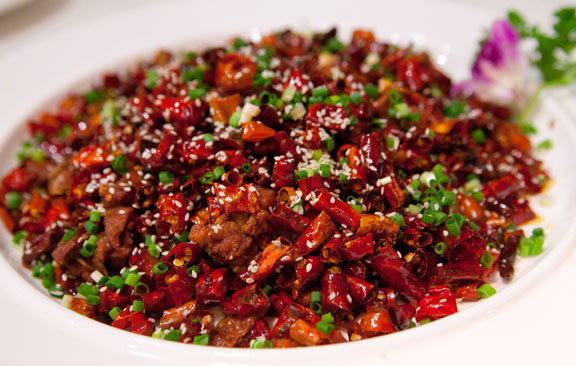Chengdu was the second city in the world that UNESCO named a City of Gastronomy in the Creative Cities Network earlier this year. All the more reason why I was excited to tag along with my husband on his assignment in this area in September, and all the more reason why I wish I had more than one day in the city! (We spent most of our time at the nearby Bifengxia Panda Base, working on our first tag-team story. If you don’t come here for the food, come for the baby pandas! And, yes, that is a milk mustache. :)
In my short time here, I did manage to squeeze in some great food. Chengdu is located in Sichuan Province, known for its mala flavor — that is, numbing and spicy! The numbing effect comes from the Sichuan peppercorn, which creates a tingling sensation in the mouth and isn’t so much hot as it is fragrant. The heat comes instead from lots and lots of chili peppers, whether fresh or dried. In fact, one of the things my husband’s Chinese researcher told us about is this delicious local dish with the unfortunate nickname name of “Looking for Prostitutes in the Red-Light District”! The play on words comes from chicken, which is also slang for “prostitute” in Chinese. The dish consists of fried bite-sized pieces of chicken buried in a mound of dried red chili peppers. The chicken is crispy and loaded with mala flavor, and it’s stir-fried with peanuts and scallions.
We had our share of hot pot in Sichuan, where it is tremendously popular. A friend of ours told us about how he walked into a hot pot restaurant in Sichuan to find it full of businessmen in nice trousers but with their shirts and ties taken off because they were sweating so much from the spice!
 Hot pot in nearby Ya’an, where we opted for a non-spicy broth. Still plenty of chili on the side to go around.
Hot pot in nearby Ya’an, where we opted for a non-spicy broth. Still plenty of chili on the side to go around.
I also made it to Jinli Street, a fun tourist spot made up of winding ancient streets, temples, archways, and, of course, your local Starbucks. It also has some of the most amazing street-food stalls!
And lastly, I paid a little visit to Chen’s Mapo, where I had mapo doufu (that’s mapo tofu — mapo allegedly derived from the grandma Chen who created the dish and supposedly had a pockmarked face; this version was meatless, but it’s often got ground pork or beef), qingjiao roupian (pork slices stir-fried with garlic and lots of fresh green chilies), and dandan mian (noodles with minced pork and a salty, mala, and sometimes vinegary sauce).
Chengdu was named City of Gastronomy not least in part for its famed street food, characteristic Sichuanese flavors, and ancient food traditions. It’s one of the last major cities in China to still have wet markets, though this seems to be changing. Like the rest of the China, Chengdu is modernizing quickly, with buildings being torn and built every day. When I was there, I found it hard to come upon “authentic”-looking family establishments, especially since I only stayed one day. My guide was pretty much the Chengdu posts on Robin Eckhardt’s Eating Asia blog. But even with the posts, the small alleys can be hard to track down, especially with the city changing so quickly and dramatically. I only hope that UNESCO status will encourage the local government to preserve some of the more historic and traditional neighborhoods and eateries that earned it the position in the first place.
















Connect with us